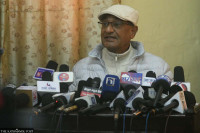National
Education Ministry makes a push for not counting illiterate persons during census
The ministry fears its claim on literacy rate could be called into question if 2021 census comes up with different figures, statistics bureau officials say.
Binod Ghimire
As the National Planning Commission and its Central Bureau of Statistics work on the questionnaire for the new national census, the Ministry of Education is making a push for not counting the illiterate population, saying the country will have achieved “total literacy” by then. The next national census, conducted every 10 years, will be taken in 2021.
The government has announced to achieve total literacy by next fiscal year, and the ministry is the line agency to execute the plan.
At a preparatory meeting held to collect suggestions to finalise the questionnaire, the ministry said it was not necessary to count the illiterate population during the census, according to an official.
“The Education Ministry came up with the proposal during a recent preparatory meeting,” Pushpa Kandel, vice-chairman of the National Planning Commission who leads the national census steering committee, told the Post.
Officials at the Education Ministry confirmed that they have forwarded the proposal, but said no agreement has been reached yet.
Mahesh Dahal, the education secretary, said as the ministry has the most comprehensive data on the country’s literacy, it is not necessary to count illiterate population during the census.
“We have collected extensive details on illiterate population and we aim to make them literate in the next two years,” Dahal told the Post. “Counting them again [during census] will be a waste of time.”
Officials familiar with the development, however, say the Education Ministry’s push for not counting the illiterate population during census stems from the fear that census data could contradict the ministry’s records.
Different media reports in the past have shown those who were “literate” in the ministry’s records were actually illiterate.
“The ministry fears its claim of total literacy could come into question if its data do not match with the census report,” said an official at the Central Bureau of Statistics on condition of anonymity. According to the official, the census must include illiterate population to verify the ministry’s claim.
Dahal, the ministry official, however, said he doubts the enumeration during the census would be “at par with the records collected by the ministry”.
“The director-general at the statistics bureau and his counterpart at the Centre for Education and Human Resource Development are in talks to finalise the issue,” he said.
Eliminating illiteracy has been the goal of successive governments since fiscal year 2008/09. The government then had launched an ambitious National Literacy Campaign, allocating Rs 1.04 billion. It announced that the country would achieve total literacy within two years. The government allocated an equal amount the following year.
The government in fiscal year 2012/13 conducted a door-to-door survey to find out the exact number of illiterate population in the country. The total literacy programme was rebranded as the Literate Nepal Campaign the same year. The campaign aimed to make 4,054,649 adults—the number of illiterate persons according to the survey—able to read and write by the end of the fiscal year 2015-16. A total of Rs 2.68 billion was allocated for three years.
The government missed the target again. Yardsticks, however, began to change to “total literate local bodies and districts”. A district gets the fully literate status when 95 percent of people aged five years and above can read and write. By the end of the fiscal year 2015-16, only 22 districts could achieve the fully literate status. The government so far has declared 51 districts fully literate. This means turning the corner for 26 more districts in the next two years—19 this year and seven more the following year.
In the past decade, the government has spent over Rs 11 billion in the literacy campaign, but total literacy is yet to be achieved.
The literacy rate, according to the National Census 2011, stands at 65.5 percent. According to the previous census conducted in 2001, Nepal’s literacy rate was 53.74 percent for people aged six years and above. The ministry says the current literacy rate is above 80 percent.




 11.12°C Kathmandu
11.12°C Kathmandu













%20(1).jpg&w=300&height=200)

